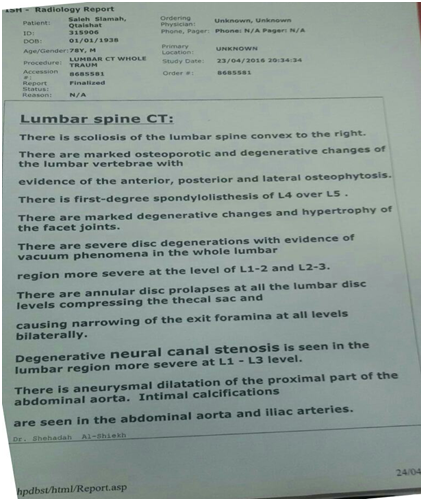Journal of
eISSN: 2373-6437


Case Report Volume 7 Issue 4
Anesthesia & Pain Management Consultant, Prince Hashim Military Hospital, Jordan
Correspondence: Ahmad Al-Shraideh, Anesthesia & Pain Management Consultant, Prince Hashim Military Hospital, Jordan, Tel +962776861785
Received: March 03, 2017 | Published: March 9, 2017
Citation: Al-Shraideh AZ (2017) Intrathecal Catheter in Acute and Chronic Pain Management. J Anesth Crit Care Open Access 7(4): 00269. DOI: 10.15406/jaccoa.2017.07.00269
Again, spinal subarachnoid catheter proved to be very effective in Pain Management as well as Surgical Anesthesia, as shown in our opinion “The Importance of Subarachnoid Catheter in Low Dose Spinal Anesthesia Technique” Published on April 19, 2016 in Med Crave: Journal of Anesthesia & Critical Care, Volume 4 Issue 5 - 2016, so I’m going to discuss this special case of Saleh Slamah Qtaishat, 78 year old male, not known to be diabetic or hypertensive. This patient is the father of Dr. Bilal Qtaishat, Anesthetist Doctor at Prince Hashim Military Hospital, Aqaba - Jordan.

Patient C/O low back pain for 3 years, radiating to both lower limbs, which was burning in nature associated with attacks of paresthesia, not responding well to usual non-steroidal anti-inflammatory drugs, and because of the abusive usage of the drugs, the patient developed upper GI bleeding twice, for the last upper GI bleeding attack he needed blood transfusion (8 units).
The cause of the patient’s pain is shown in the below Radiological Report:
The treatment modalities that have been tried on the patient are:
All of the above mentioned treatment modalities failed to satisfactory relieve the pain of the patient.
So, on the light of our successful and encouraging results in using intrathecal catheter for anesthesia and post-operative pain management on many patients, I’ve decided to try it to relieve the pain of this patient. Fortunately, Dr. Bilal & his father (the patient) agreed to proceed with the treatment. The Catheter was implanted into the intrathecal space at the level of L2-L3 intervertebral space, and the catheter was advanced 3cm from the Dura into the subarachnoid space, then the rest of the catheter was totally secured subcutaneously, except the administration port, which included a bacterial filter port. The procedure was done under local anesthesia using lidocaine 1%, and under complete sterile technique.
Half ml of plain bupivacaine 0.25% was used as an initial dose for pain relief. Surprisingly, this dose was sufficient to completely relief the pain for 24 hrs, where the second dose was given via the catheter, which was as sufficient as the first dose.
The procedure was done at the hospital, the patient was released after 2 days with the catheter, and a relative was instructed to administer the drug. The catheter was left in situ for 4 months, until it was accidently removed, after which the pain returned. During the 4 month period, sometimes the patient needed 2 doses per day.
No changes of vital signs was observed. No changes of muscle power, therefore the patient was able to move freely. No unwanted side effects were seen, such as: post-spinal headache, infection or back pain on the site of the catheter.
The intrathecal catheter can be used safely for pain stop during and after surgery, also for chronic pain as shown in this case. The very small dose of plain bupivacaine used for surgical anesthesia, which is in order of 2.5-5 mg, was sufficient to produce initial surgical anesthesia, guided me to try smaller doses in order of half ml of 0.25% plain bupivacaine for post-operative pain stop, and it was very effective in pain stop for a duration of 12-24 hrs.
Intrathecal catheter in anesthesia can be used effectively not only for major lower limb surgeries, but also for major intraabdominal surgeries by using the same initial dose of 0.5-1 ml of 0.5% plain bupivacaine, which I will show in the upcoming case presentation. I believe that this catheter can be used for intrathoracic surgeries, but this needs a special catheter, which can pass up to the thoracic and even to the cervical spine from L2-L3 or L3-L4 intervertebral space level, without coiling or kinking. A special totally subcutaneously implantable intrathecal catheter can be used successfully for special cases of chronic pain, especially where other treatment modalities of pain relief fail, or where the outcome of surgery is questionable, or when patients refuse surgery. So, such catheter can be used for different kinds of surgeries at any time a surgery is indicated.
None.
There is no conflict of interest.
None.

©2017 Al-Shraideh. This is an open access article distributed under the terms of the, which permits unrestricted use, distribution, and build upon your work non-commercially.